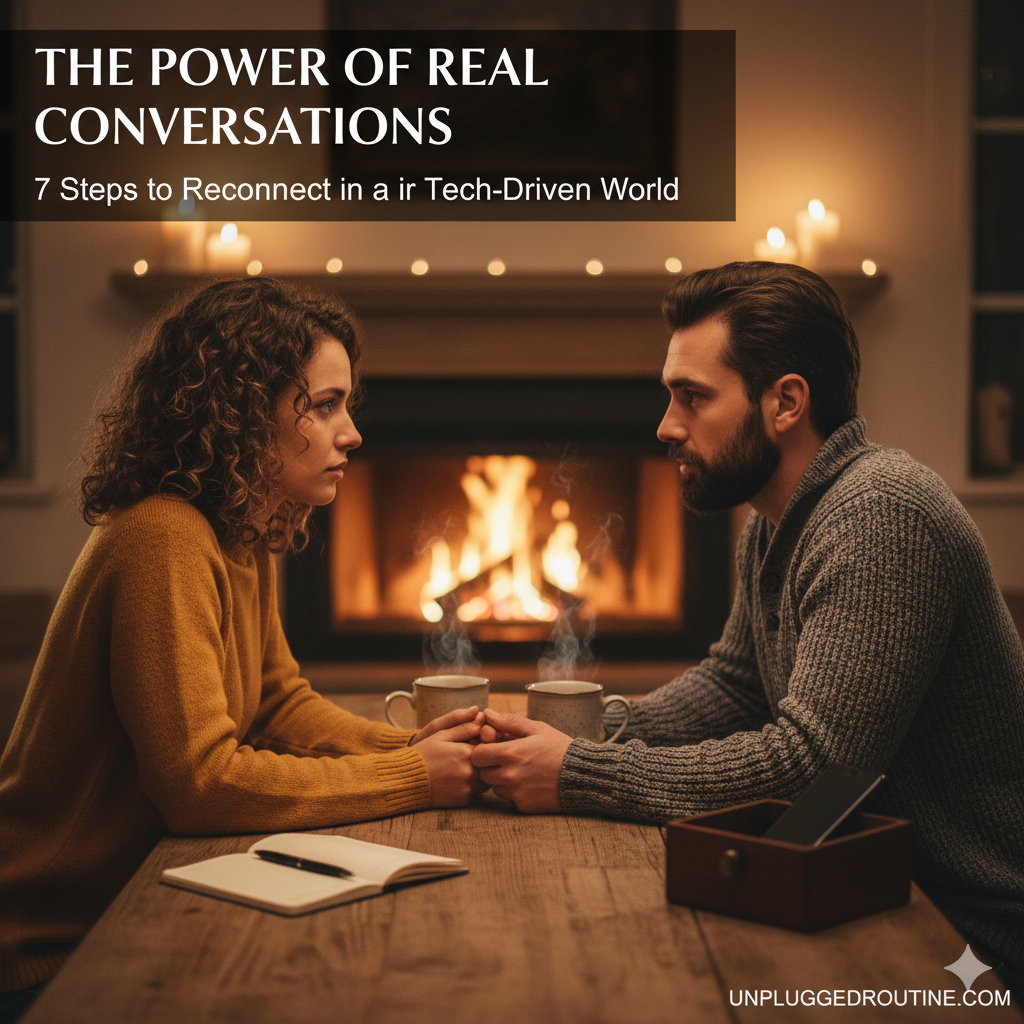In a world buzzing with notifications, emojis, and fleeting digital interactions, when was the last time you had a real conversation? You know, the kind where you truly listen, make eye contact, and feel a genuine connection with another human being?
At UnpluggedRoutine.com, we believe that the art of conversation is not lost, just misplaced. In our tech-driven society, it’s easy to mistake a flurry of texts or a quick video call for genuine connection. But there’s a profound, almost magical, power in sitting down, putting screens away, and engaging in deep, meaningful dialogue. It’s how we build trust, foster intimacy, solve problems, and truly understand each other.
This isn’t just about being polite; it’s about safeguarding our mental health, strengthening our relationships, and nurturing our very humanity. If you’ve ever felt a pang of loneliness despite being “connected” to hundreds of people online, then you know exactly what we’re talking about.

The Silent Erosion: How Technology Changes Our Conversations
Before we dive into how to reclaim this essential skill, let’s acknowledge the challenge. Technology, while incredible for efficiency and global reach, has subtly reshaped our conversational habits:
- Attention Spans Shrink: Constant digital stimulation trains our brains for quick hits of information, making sustained focus on one person’s words more difficult.
- Surface-Level Interactions Reign: Emojis and short messages often replace nuanced expressions, leading to shallower communication.
- Fear of Missing Out (FOMO): The constant urge to check our phones can interrupt conversations, sending a subtle message that the person in front of us isn’t our top priority.
- Loss of Non-Verbal Cues: Digital communication strips away body language, tone of voice, and facial expressions – 70-93% of how we communicate! This often leads to misunderstandings.
- The Echo Chamber Effect: Online, we often surround ourselves with like-minded individuals, reducing our exposure to diverse perspectives that enrich real-world conversations.
It’s time to push back against this tide. It’s time to intentionally cultivate the power of real conversations.
Why Real Conversations Are Your Relationship Superpower
Think about the most important people in your life: your partner, family, close friends, colleagues. What truly binds you? It’s likely not your shared Netflix watch list, but the conversations you’ve had – the deep talks, the vulnerable moments, the shared laughs, the empathetic listening.
Real conversations:
- Build Deeper Intimacy: They create a sense of knowing and being known, essential for strong relationships.
- Foster Empathy: Truly listening allows you to step into another’s shoes and understand their perspective.
- Solve Problems More Effectively: Digital back-and-forths can lead to misinterpretations; direct conversation clarifies.
- Reduce Loneliness & Stress: Connecting authentically releases oxytocin, the “bonding hormone,” which reduces stress.
- Spark Creativity & Learning: Diverse perspectives shared in open dialogue can lead to new ideas and insights.
- Boost Confidence: Being heard and understood affirms our value and builds self-esteem.
Ready to harness this superpower? Let’s explore 7 actionable steps to reconnect through real conversations in our tech-driven world.
7 Steps to Reconnect Through Real Conversations in a Tech-Driven World
These steps are designed to be practical, easy to implement, and transformative. Choose one or try them all!
Step 1: Declare a “No-Phone Zone” – The Ultimate Game Changer
This is the most fundamental step. You cannot have a real conversation if a phone is present and actively distracting. It’s simply impossible to give someone your full attention when you’re subconsciously (or consciously!) waiting for a ping.
- The Hook: Before your next meal, coffee date, or even just a chat on the couch, declare a “No-Phone Zone.” Decide where the phones go (another room, a designated basket, facedown and silent out of reach) and agree to respect it.
- Why it Works: This simple act sends a powerful message: “You are more important than my phone.” It eliminates the temptation, reduces anxiety, and creates an immediate space for focused interaction.
- Try This: Start with 30 minutes. Extend it to an hour. Make dinner a consistent No-Phone Zone. You’ll be amazed at the difference.
Step 2: Master the Art of Active Listening – Hear, Don’t Just Wait to Speak
Most of us are terrible listeners. We’re often formulating our response while the other person is still talking. Active listening is about truly absorbing what the other person is saying, both verbally and non-verbally.
- The Hook: Challenge yourself to listen for understanding, not just to reply.
- Why it Works: When someone feels truly heard, they feel valued and understood. This encourages them to open up more, deepening the conversation. It also prevents misunderstandings.
- Try This:
- Eye Contact: Maintain appropriate eye contact.
- Body Language: Lean in slightly, nod, show you’re engaged.
- Clarifying Questions: Ask “What do you mean by that?” or “Can you tell me more?”
- Summarize/Reflect: Occasionally, rephrase what you’ve heard: “So, if I understand correctly, you’re feeling frustrated because…”
- Silence: Don’t be afraid of pauses. Sometimes people need a moment to gather their thoughts.
Step 3: Ask Open-Ended Questions – Beyond “Yes” or “No”
“How was your day?” often gets a “Good.” End of conversation. To unlock deeper dialogue, you need questions that invite detailed responses.
- The Hook: Prepare a few thought-provoking questions before your next conversation.
- Why it Works: Open-ended questions encourage reflection, storytelling, and sharing personal experiences, moving the conversation beyond superficial exchanges.
- Try This:
- Instead of “Did you have a good day?”, try “What was the most interesting part of your day?” or “What challenged you today?”
- Instead of “Are you okay?”, try “What’s been on your mind lately?” or “How have you been truly feeling about X?”
- “What’s something new you learned recently?”
- “What’s a dream you have that you haven’t talked about much?”
- “If you could have dinner with any historical figure, who would it be and why?”
Step 4: Share Vulnerability (Appropriately) – The Path to Intimacy
Real conversations often require a degree of vulnerability. Sharing a piece of yourself – a struggle, a dream, a fear, a joy – invites the other person to do the same, creating a powerful bond.
- The Hook: Take a small risk. Share something personal you might usually keep to yourself.
- Why it Works: Vulnerability is a cornerstone of intimacy and trust. It shows authenticity and gives others permission to be authentic in return.
- Try This: Start small. You don’t have to spill your deepest secrets immediately. Share a minor challenge you faced, a small fear, or a moment of unexpected joy. Observe how the other person responds. This builds a foundation for deeper sharing.

Step 5: Embrace Disagreement with Respect – The Foundation of Growth
Real conversations don’t always mean agreeing. In fact, some of the most profound connections are forged when we navigate differing opinions with respect and curiosity. The digital world often fosters polarization; real conversation can bridge divides.
- The Hook: Instead of debating to win, try conversing to understand.
- Why it Works: Learning to respectfully discuss differences strengthens relationships by demonstrating mutual respect and intellectual curiosity. It also broadens your own perspective.
- Try This:
- Listen First: Before presenting your counter-argument, genuinely try to understand their point of view.
- “I” Statements: Frame your disagreements with “I feel…” or “From my perspective…” rather than “You’re wrong.”
- Find Common Ground: Even if you disagree on the main point, can you find areas of shared value or concern?
- Agree to Disagree: Sometimes, the most respectful outcome is to acknowledge your differences and move on without resentment.
Step 6: Create Dedicated “Conversation Spaces” – Intentional Connection
In our busy lives, real conversations rarely “just happen.” We often need to create the time and space for them, away from daily tasks and digital noise.
- The Hook: Schedule a “conversation date” with your partner, friend, or family member.
- Why it Works: Intentionality is key. By setting aside specific time and space, you elevate the importance of the conversation and ensure it happens.
- Try This:
- Walk and Talk: Go for a walk together without phones. The rhythmic motion can often facilitate conversation.
- Coffee/Tea Dates: Designate a weekly or bi-weekly coffee date where the primary goal is conversation.
- Car Rides: Turn off the radio and use commute time for focused chat.
- “Table Talk”: After dinner, linger at the table for 15-20 minutes, just talking.
Step 7: Practice Mindful Presence – Be Here, Now
This step underpins all the others. Mindful presence is the ability to fully engage in the current moment, letting go of distractions from the past or worries about the future. It’s the antidote to digital brain drain.
- The Hook: Before your next conversation, take a few deep breaths and consciously ground yourself in the moment.
- Why it Works: When you are mindfully present, you are truly available for the other person. Your attention isn’t split, and your ability to listen and respond empathetically is heightened.
- Try This:
- Sensory Awareness: Before a conversation, notice five things you can see, four you can hear, three you can feel, two you can smell, and one you can taste. This brings you into the present.
- One Thing at a Time: Resist the urge to multitask. If you’re talking, just talk. If you’re listening, just listen.
- Gentle Return: When your mind wanders (and it will!), gently bring your focus back to the person speaking.
The Ripple Effect of Real Conversations
Embracing the power of real conversations isn’t just about transforming individual interactions; it’s about reshaping your entire approach to connection. As you practice these steps, you’ll notice a ripple effect:
- Stronger Relationships: Your bonds with loved ones will deepen, built on a foundation of mutual understanding and respect.
- Increased Empathy: You’ll become more attuned to the feelings and perspectives of others, making you a better friend, partner, and colleague.
- Reduced Stress: Authentic connection is a powerful stress reliever. Knowing you are truly seen and heard is incredibly comforting.
- Greater Self-Awareness: Through deep conversations, you often learn more about yourself – your values, your beliefs, and your own patterns of communication.
- A More Meaningful Life: Ultimately, a life rich in real conversations is a life rich in meaning and fulfillment.
Conclusion: Choose Connection Over Clicks
In our fast-paced, tech-saturated world, the power of real conversations stands as a beacon for genuine human connection. It’s an antidote to loneliness, a catalyst for intimacy, and a fundamental building block of strong relationships and a vibrant society.
You have the choice. You can let the digital tide sweep you into a sea of superficial interactions, or you can intentionally anchor yourself in the rich, deep waters of real conversation. It takes practice, patience, and a willingness to be present, but the rewards are immeasurable.
So, at UnpluggedRoutine.com, we challenge you: put down your device, look up, and lean into the beautiful, messy, and utterly essential art of talking and truly listening. Your relationships – and your well-being – will thank you for it.
Ready to start? Which of these 7 steps will you implement first to bring more real conversations into your life today? Share your thoughts and experiences in the comments below!